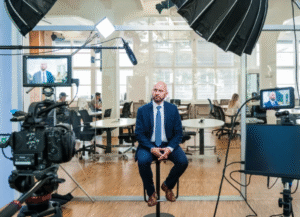Creating video content that enhances the perception of your business used to mean booking expensive studio time weeks in advance.
Today, you can record in a high-end studio, capture footage on-site, or record remotely from your living room on your laptop. Each option can deliver broadcast-quality results and comes with its own balance of cost, control and creative opportunity.
The look and feel of your content will depend on the look and feel of your brand. Your budget, timeline and your marketing and communication goals also need to be considered. Below, we break down the pros and cons of each approach so you can choose the one that makes the most sense for your next project.
1. Studio Recording – Polish & Precision
Filming or recording audio in a purpose‑built, acoustically treated space. Fluent Media film in a studio near Bromley North train station, but work with studios all over London, with access to green screens, LED walls, isolation booths, and professional lighting rigs.
Showcasing Products
We do a lot of location based shoots and we also use our custom-built multi-purpose film, video and photography studio in Bromley for filming livestreams and podcasts.
Currently we’re seeing an increase in requests for studio-based product shoots.
Pros
- Controlled environment: We have complete control over temperature, lighting, outside noise and Wi-Fi connection.
- Predictable costs: With studio hire, known line items mean you’re not gambling on weather or location permits.
- Additional space: adjacent rooms can be used for planning and as a waiting area for guests in between shoots.
- Specialist equipment: High-frame-rate cameras, broadcast quality microphones, tracks, dollies and lighting grids.
- Scalability: Easily add teleprompters, live switching, or a green screen for virtual sets.
Cons
- Higher cost: Studio rental, crew and equipment hire will exceed the budget of filming at your business premises.
- Less spontaneity: It’s harder to capture candid moments in a highly managed space.
- Logistics: Getting your staff any guests or props to the studio requires planning and travel costs, depending on the location.
Best for
Premium brand campaigns, product demos that need perfect lighting, video podcasts with VIP guests, multi‑camera panel discussions, or any project where you need complete control over what’s captured.
Case Study – Our Most Successful Client Project (in terms of ROI)
The series of films below were produced by Matt Castle in 2013 for Kevin Pritchard, MD of www.4rbusinessrecovery.co.uk. Filming took place in 2 separate studios over 2 days.
Kevin continues to use them on his website today to generate new leads and enquires. He says these videos have lead to new relationships and business opportunities that have exceeded £2million in value over the past 12 years.
2. On-Location Recording — Authenticity & Atmosphere
Bringing cameras, lights, and mics to the environment where your story unfolds organically. Your flagship store, home, office or factory – even a windswept coastal cliff.
Pros
- Built-in storytelling: Give viewers a sense of your culture and context. Lots of opportunities for filming b-roll footage, cuts in between ‘talking heads’.
- Natural energy: People (and viewers) feel relaxed on familiar turf, real‑world backdrops create instant credibility and visual interest.
- Cost-efficient for certain shoots: Avoid studio fees.
Cons
- Uncontrollable variables: The weather, changing sunlight, unpredicted travel or insurance costs.
- Unpredictable acoustics: Aircraft overhead, background noise from people or crowds can affect audio quality.
- Permits & permissions. Site owners, council officials and Health & Safety compliance often require paperwork and fees.
Best for
Case-study videos, documentaries, client testimonials, brand origin stories, events, real-estate walkthroughs and social-media edits where place is part of the message.
Case Study Example – 100 Shoreditch
Learn more about this approach and see other videos produced as part of this series, here.
3. Online Recording – Speed & Reach
Capturing audio or video remotely, with each participant joining from a different location. At Fluent Media we typically use Streamyard, a browser-based HD recording platform.
Pros
- Ultra-low cost: No venue hire, travel or large crews.
- Global talent: Schedule recordings whenever guests are available, regardless of time zones. Guests may appear more relaxed/ feel more comfortable if filmed in their own home or office.
- Rapid turnaround: Immediate upload to the cloud plus built-in transcription and editing tools speed up the post-production process.
Cons
- Quality constraints: Dependent on each guest’s camera, mic and internet stability. Glitches, lagging or user error can cause disruptions and delays.
- Limited creative control: Framing, lighting, make-up styling, background they will be filmed against will be inconsistent, resting with the participant.
- Engagement challenges: Viewers can sense when people aren’t in the same room. Limited creative options that can only be enhanced during post production.
Best for
Thought-leadership podcasts or interviews, employees sharing experiences or stories related to company values, webinars, introductions to team members to welcome new staff, internal training modules, and content where speed and budget override production values.
Case Study Example – Yelp
See other examples of films we’ve produced for Yelp in a similar style here.
4. How to Decide: A Quick Framework
Ask yourself these 5 questions:
- What level of polish does your audience expect?
Think about where audiences will watch or listen. Cinema pre-roll demands premium quality; Instagram viewers will forgive visible lapel mics. - What style of production will push their perception of your brand to the next level?
This applies to both internal and external communication. Existing employees may be okay with talking heads style videos recorded remotely and enhanced with motion gfx, those applying to join your company may appreciate seeing the environment they will be working in if and when they join. If the setting is part of the narrative, on‑location is hard to beat. - What is important is noise quality?
Sensitive audio (e.g., ASMR, product sound demos) would be best recorded in a studio; animated keynote slides might cope with an external mic and recorded via a HD recording platform. - How quickly do you need it delivered?
Studios streamline workflows, but remote recording can be within 1- 3 days- depending on the amount of post production work required. - How will you define success?
For conversions and engagement, being seen as real and authentic is more important than polish. For some investors, higher production values can communicate professionalism.
Budget Snapshot
Studio: £2,500 – £20,000 + (size of space, location, crew, specialist equipment, final deliverables)
On‑Location: £1,500 – £15,000 + (crew, number of locations + days filming, gear, permits, post production requirements)
Online/Remote: £500 – £1,200 per recording (which platform, number of recordings, if remote producer and a interviewer are needed)
Figures include average UK market rates in 2025 and assume a lean, professional crew. Actual costs vary by duration, complexity, and time spent on post production.
Final Thoughts
There’s no one-size-fits-all answer. It’s only by considering the perception you want to create with audience and the impression you want to leave them with, along with your budget and timescale expectations, can you match your recording environment to the story you need to tell.
Need a sounding board? Fluent Media helps brands plan, produce and distribute content that resonates—wherever it’s recorded. Email us at info@fluentmedia.co.uk to arrange a time to discuss your next project.









